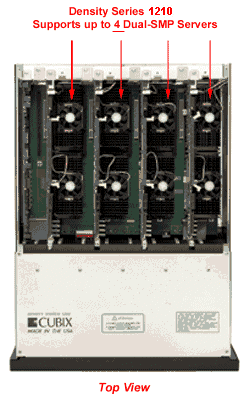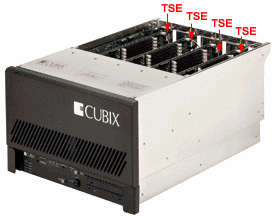Two Dual-Processor
Pentium® III's are a better choice than a single
Quad Pentium III System in a Window 2000 and TSE
Environment
In many Microsoft
Windows 2000 server environments, you will find
that Cubix Density Series™ systems with two
dual-processor server blades are less expensive,
more resilient, and a better value than one quad
server.
We’ll use Microsoft®
Windows 2000 running Terminal Server Edition®
(TSE) as an example.
A server farm of
multiple server blades within the Density Series
system can be built cost effectively and with a
high level of availability by spreading TSE
services across multiple server hosts, and using
Citrix® MetaFrame® load-balancing software.
Density Series
System Availability is Higher
Continuous TSE service availability is
always ranked as the most important
aspect on network administrators’
checklists. A Density Series system with
load balancing allows you to distribute
the work load evenly and have users
automatically re-assigned to remaining
servers in the event of a failure. A
fully populated Density Series system
that has FOUR S4612 dual processing
server blades, each connected on separate
Ethernet I/O paths. The loss of a single
server blade means only 25% of the total
capacity has been lost. With the TWO dual
processor server blade example above, the
TSE service continues to operate and
users continue to work even with the loss
of one of the servers (although
performance may degrade).In the case of a
single Quad Processor TSE server, a
failure brings down the entire service.
All work stops!
|

|
Density
Series System Maintenance Issues are Lower
Everyone who runs
TSE knows that the system requires ongoing
maintenance and "tweaking". Service
patches need to be added, applications need
upgrading, error logs need to be flushed, etc.
With a Density Series multi-server system, one of
the server blades can be downed and patched,
leaving the TSE service at a reduced capacity but
still operational. Full capacity can be restored
when the server blade is brought back on line.
User productivity is not disrupted.
With a single
quad, the "tweaking" is catastrophic.
The entire unit must be brought down; therefore,
all TSE services are lost until the
"tweaking" is completed and the system
is restored. Meanwhile, user productivity, and
the associated revenue generation, STOPS! Also,
there is no way to test the "tweaks"
that were made, so there is no guarantee after
tweaking the single system that the service will
come back as planned. And no one wants
downtime—planned or unplanned!
Incremental
Cost to Scale Density Series System is Lower
The Density Series
system supports the addition of two more
dual-processor Pentium III blades within
it. Expansion can be made in low cost increments
– just by adding a blade to the existing
Density chassis.
There is no
expansion in the QUAD. If you need more
horsepower, the next increment is another QUAD.
Hidden Costs
for Density Systems are Lower
| Two QUAD systems (8
Pentium III processors total) take up
twice as much rack space (14U), plus
there is an additional rack space
requirement (2U) and additional cost for
a standalone K/V/M switch (or additional
monitors, keyboards, and mice). |
 |
Summary
With the Density
Series system, the initial hardware cost is
lower, the incremental cost is lower, the hidden
cost is lower and the TSE service availability is
higher. The Terminal Server environment is one of
many areas where multi-server Density Series 1220
systems have the clear advantage!
|

